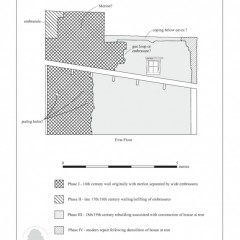
Historical building recording was undertaken between March and May 2014 by Oakford Archaeology at No 52 Northernhay Street, Exeter, in response to the redevelopment of the property.
The city Wall was originally built in the 2nd century AD to enclose the civitas of Isca Dumnoniorum. It was added to and maintained as a defensive enclosure for the city throughout the Middle Ages, and until the late 17th century was intermittently used for defensive purposes. Originally consisting of a circuit 2.35km in length, the city wall retains fabric representing all periods. For much of its circuit it retains its Roman core, although relatively few sections of the wall preserve any Roman facework. There is little evidence for Saxon fabric, but with the Norman Conquest the city wall entered into a period of probably continuous repair and maintenance which has lasted until the present century. Subjected to five major sieges in the period between 1485 and 1660, the walls ceased to function in the defence of the city after the Civil War. The circuit continued as a boundary until the removal of the gates between 1769 and 1819. During the 20th-century developments in Exeter caused the greatest losses in the circuit and today c. 1705m or 72.5% of the total circuit survives.
Located between the boundary of Northgate Court and 51 Northernhay Street a stretch of 6.7m of facework of the city wall was recorded. Three main facework builds were seen, although the facework on the ground floor was hidden by modern masonry and the first floor was partly covered in paint, making detailed recording difficult.


